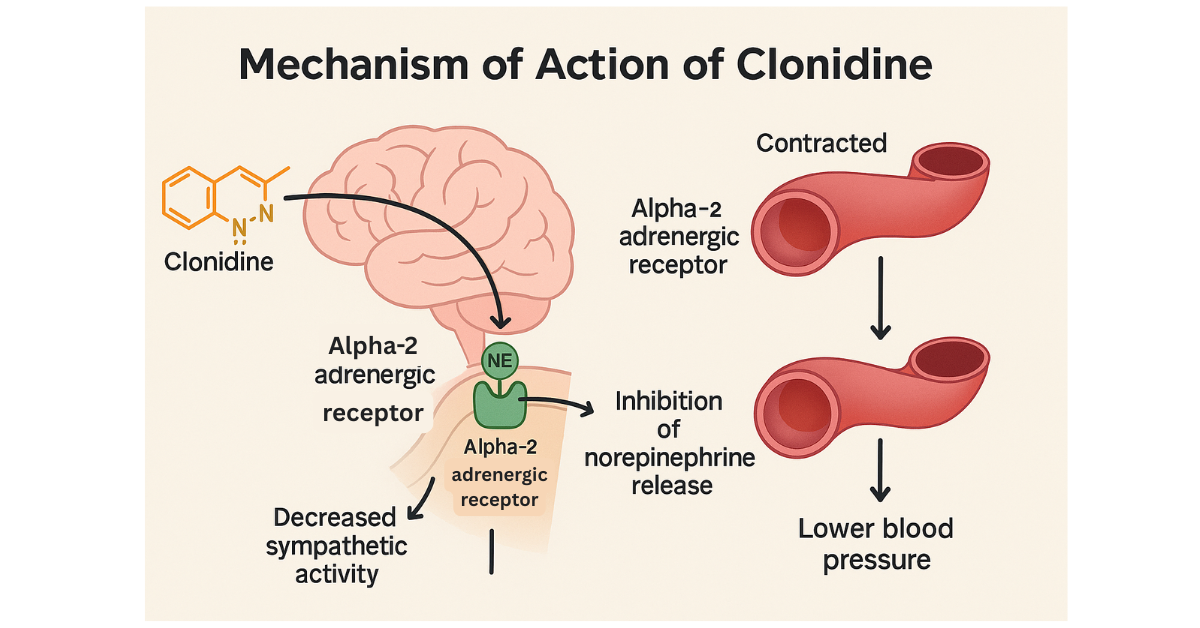Table of Contents
Introduction
Clonidine is a centrally acting α2-adrenergic receptor agonist used primarily for hypertension, but also for opioid withdrawal, ADHD, pain management, and anxiety disorders. It lowers blood pressure by reducing sympathetic outflow from the central nervous system.
Due to its broad clinical relevance and central mechanism, clonidine is a high-yield drug for exams like USMLE, NCLEX, NAPLEX, GPAT, and NEET-PG.
Mechanism of Action of Clonidine: Step-by-Step
- α2-adrenergic receptor agonist
Clonidine acts as a partial agonist at central presynaptic α2-receptors, especially in the medulla oblongata. - Inhibition of norepinephrine (NE) release
Activation of these receptors leads to reduced release of NE from sympathetic neurons via negative feedback. - Reduced sympathetic outflow
As a result, there is decreased sympathetic tone to the heart, vasculature, and kidneys. - Cardiovascular effects
- ↓ Heart rate (HR)
- ↓ Cardiac output (CO)
- ↓ Peripheral vascular resistance (PVR)
- ↓ Blood pressure (BP)
- Additional CNS effects
Clonidine also exerts sedative and analgesic actions through similar central α2 receptor activation, reducing stress responses.
Pharmacokinetic Parameters of Clonidine
| Parameter | Value |
|---|---|
| Bioavailability | ~75–95% (oral) |
| Half-life | ~12–16 hours |
| Time to onset | 30–60 minutes (oral) |
| Duration of action | ~6–12 hours (oral), longer with patch |
| Protein binding | ~20–40% |
| Metabolism | Hepatic (partially) |
| Excretion | Renal (mostly unchanged) |
| Route | Oral, transdermal, epidural |
Clinical Uses of Clonidine
- Hypertension (especially resistant cases)
- Hypertensive urgency
- ADHD (especially in children)
- Opioid withdrawal
- Tourette’s syndrome
- Hot flashes (menopause)
- Adjunct in pain management (epidural infusion)
- Anxiety disorders (off-label)
Adverse Effects of Clonidine
- Dry mouth (xerostomia)
- Sedation and drowsiness
- Bradycardia
- Constipation
- Rebound hypertension (on sudden withdrawal)
- Depression
- Sexual dysfunction
- Orthostatic hypotension
Comparative Analysis: Clonidine vs Methyldopa
| Feature | Clonidine | Methyldopa |
|---|---|---|
| MOA | Central α2 agonist | Converted to α-methyl-NE (α2 agonist) |
| Onset of action | Faster | Slower |
| Use in pregnancy | Not preferred | Drug of choice in pregnancy |
| Sedation | More prominent | Moderate |
| Rebound hypertension | Yes (on withdrawal) | Less frequent |
Practice MCQs
Q1. Clonidine primarily acts on which receptor?
a. β1-adrenergic receptor
b. α1-adrenergic receptor
c. α2-adrenergic receptor ✅
d. Dopamine receptor
Q2. Clonidine lowers blood pressure by:
a. Decreasing renin release
b. Increasing cardiac contractility
c. Reducing sympathetic outflow ✅
d. Blocking calcium channels
Q3. Which of the following is a common side effect of clonidine?
a. Tachycardia
b. Anxiety
c. Dry mouth ✅
d. Diarrhea
Q4. Abrupt withdrawal of clonidine may cause:
a. Bradycardia
b. Rebound hypertension ✅
c. Hypoglycemia
d. Hyperkalemia
Q5. Clonidine is used in all EXCEPT:
a. Opioid withdrawal
b. ADHD
c. Hypertension
d. Hyperthyroidism ✅
Q6. CNS action of clonidine includes:
a. Seizure activity
b. Stimulant effects
c. Sedation ✅
d. Euphoria
Q7. Route with longer duration of clonidine:
a. Oral
b. IV
c. Transdermal ✅
d. Inhalation
Q8. Which receptor does clonidine NOT affect?
a. α2
b. β1 ✅
c. CNS
d. Medullary vasomotor center
Q9. Which is an advantage of transdermal clonidine?
a. Rapid onset
b. Avoids GI side effects ✅
c. Higher dose needed
d. Poor compliance
Q10. Clonidine effect on the heart includes:
a. Positive chronotropy
b. Bradycardia ✅
c. Tachyarrhythmia
d. Increased contractility
FAQs
Q1: Can clonidine be used long-term for hypertension?
Yes, but requires careful monitoring due to tolerance and rebound risk.
Q2: Is clonidine safe in pregnancy?
No, it is not the first choice. Methyldopa is preferred in pregnancy.
Q3: How is clonidine withdrawal managed?
By gradual tapering of the dose. Abrupt discontinuation is avoided.
Q4: Can clonidine be used in children?
Yes, especially in ADHD, but under medical supervision.
Q5: Does clonidine affect renin-angiotensin system?
Indirectly — by reducing sympathetic tone to kidneys, it may lower renin release.
References
- KD Tripathi – Essentials of Medical Pharmacology
- Goodman & Gilman – The Pharmacological Basis of Therapeutics
- Sparsh Gupta – Review of Pharmacology
- NCBI: https://www.ncbi.nlm.nih.gov/books/NBK459336/
I am pursuing MBA in pharmaceutical management from NIPER Hyderabad with a strong academic record and proven success in national-level pharmacy entrance exams. I secured AIR 61 in NIPER 2024 (MS/M.Pharm) and AIR 27 in NIPER MBA, along with AIR 147 in GPAT 2024 and AIR 907 in GPAT 2023. I also achieved AIR 6 in AIIMS CRE-2025 for Drug Store Keeper and was selected as a Pharmacist (AIR 61) for ESIC. Additionally, I was the Runner-Up in Round 2 of the EY Case Study Competition.
At PharmacyFreak.com, I aim to guide future pharmacists through expert content, exam strategies, and insightful resources based on real experience and academic excellence.
Mail- harsh@pharmacyfreak.com
